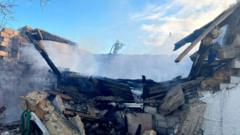Deadly Attack in Syria on U.S. Troops Exposes Growing Challenges for Country’s Leader

© Daniel Berehulak/The New York Times

© Daniel Berehulak/The New York Times

© John Moore/Getty Images
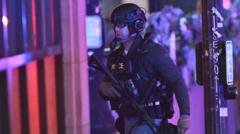
香港和澳门特首星期一前往北京述职,香港特首李家超将向中国国家主席习近平汇报大埔致命火灾相关情况。
香港和澳门特区政府网站公布, 香港特首李家超和澳门特首岑浩辉将于星期一(12月15日)至星期三(17日)前往北京述职。
岑浩辉将向国家领导人汇报澳门特区政府过去一年的施政工作和2026年的施政重点。他不在澳门期间,由行政法务司司长黄少泽临时代理特首职务。
与此同时,李家超将向国家领导人汇报香港经济、社会和政治等方面的最新情况。行政长官办公室主任叶文娟和行政长官私人秘书黄霆芝将会随行。
李家超星期五(12日)召开记者会宣布成立独立委员会调查大埔火灾时透露,他赴北京述职时,将向习近平汇报火灾情况,以及独立委员会的工作进度。
大埔宏福苑11月26日发生香港近80年来最严重火灾,造成160人死亡。社会对起火原因的高度关注。
在李家超离港期间,政务司司长陈国基将署理行政长官职务。

(德国之声中文网)德国巴伐利亚州警方近日逮捕了5名涉嫌策划对圣诞市场实施恐怖袭击的男子。负责调查的慕尼黑检察官办公室目前尚未公布案件的具体细节,仅表示初步判断作案动机与极端伊斯兰主义有关。嫌疑人显然将目标锁定在巴伐利亚州丁戈尔芬(Dingolfing)附近的一处圣诞市场,并可能计划使用车辆实施袭击。丁戈尔芬距慕尼黑约100公里。
这5名男子于本周五(12月12日)被捕。目前尚不清楚警方是如何追踪到他们的,也未披露其拟使用的具体作案车辆。
调查人员称,被捕者包括一名56岁的埃及籍男子、一名37岁的叙利亚籍男子,以及三名年龄分别为22岁、28岁和30岁的摩洛哥籍男子。检察官办公室指出,这名埃及籍伊斯兰教传教士涉嫌在丁戈尔芬—兰道地区的一座清真寺内号召发动袭击,并煽动“造成尽可能多的死伤”。
据称,三名摩洛哥籍嫌疑人已做好实施袭击的准备,而那名居住在德国北部的叙利亚籍男子则怂恿他们作出实施袭击的决定。
德新社报道称,目前尚无证据表明该案与恐怖组织“伊斯兰国”(IS)存在关联。
巴伐利亚州内政部长约阿希姆·赫尔曼(Joachim Herrmann)表示:“得益于安全部门之间的出色协作,多名嫌疑人在极短时间内被捕,从而成功阻止了巴伐利亚州可能发生的一起伊斯兰极端主义袭击。”
DW中文有Instagram!欢迎搜寻dw.chinese,看更多深入浅出的图文与影音报道。
© 2025年德国之声版权声明:本文所有内容受到著作权法保护,如无德国之声特别授权,不得擅自使用。任何不当行为都将导致追偿,并受到刑事追究。
Rumours of a major prisoner release from Belarus had been swirling for a couple of days.
But no one would reveal the names on the list, or the exact number, until everyone was safely out, finally free.
In total,123 political prisoners have been released, including some of the best-known names among Belarusian opposition politicians, human rights activists and journalists.
Maria Kolesnikova, the protest leader with a famous red-lipsticked smile, was on the release list.
A video of her jumping for joy and hugging other former prisoners, overjoyed to be reunited, was soon flying around social media. Then came another, on a bus out of Belarus, where she thanked everyone who'd helped bring this moment about.
"It's a feeling of incredible happiness to see those who are dear to me, to hug them and realise we are all free," Masha, as she's best known, told the camera, her lips already painted red again.
The first sunset of her freedom was a thing of great beauty, she said.
"But I also think of those who are not yet free and I await the moment when we can all embrace, when all are free."

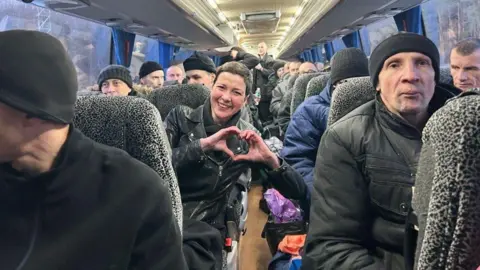 Reuters
ReutersOut too is Viktor Babaryka, a banker who tried to run for president in 2020 but was locked up before the elections even began.
The Nobel Peace prize winner Ales Bialiatski has also been released from a 10-year sentence.
All were locked up for their opposition to the authoritarian rule of Alexander Lukashenko, whose security forces crushed the mass protests of 2020 with brutal force. They were the biggest challenge to his rule that he has ever faced.
The prisoners' release now is the result of long and complex negotiations led by the US that culminated in a two-day visit to Minsk this week by Donald Trump's new special envoy, John Coale.
For Lukashenko, that engagement itself is a win: after years as a political pariah in the West he is clearly happy to be back on talking terms with the US.
But he also got US sanctions dropped on a key export for his country, potash, as a further, more tangible reward. EU penalties - and tougher policies - are still in place.
It's not entirely clear what Trump has to gain from this. But Belarus is a close ally of Russia, including in its war on Ukraine, and the move comes as the US has been re-engaging with Moscow too, seeking a peace deal.

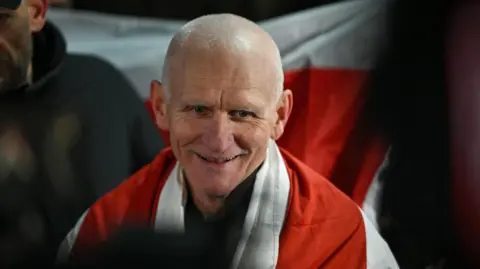 EPA/Shutterstock
EPA/ShutterstockThe dozens of prisoners Lukashenko agreed to let go were always expected to come here to Vilnius, Lithuania, where a crowd of friends, relatives and fellow activists gathered outside the US embassy in the freezing cold to greet them.
Some came wrapped in the red and white opposition flag of Belarus.
Tatsiana Khomich, Masha Kolesnikova's sister who had campaigned for over five years for her release, couldn't stop smiling. "I've just spoken to Masha," she told me after a video call.
A professional flautist before the disputed 2020 elections, Kolesnikova spent much of her more than five-year sentence in total isolation, denied even letters and phone calls to her family.
"She's fine, she's good. I just want to hug her. I still can't quite believe it," her sister said.
Suddenly, there was a commotion in the crowd: a police car, blue lights flashing, was heading towards the US embassy gates, leading a small convoy of other vehicles.
But there was no way all 123 ex-prisoners were inside. Instead, we learned, just seven foreign nationals had been brought to Lithuania and only Ales Bialiatski of the Belarusians.
The others, including Kolesnikova, had been taken out of Belarus to Ukraine: from prison, into a war zone.
Staying in their own country is not usually an option on offer.
"Lukashenko's idea, who else?" was how one of opposition leader Svetlana Tikhanovskaya's team interpreted the surprise diversion to Ukraine. It seems he'd decided to play one final power game, so the family reunions, so long awaited, would be delayed.
But what of the price paid for that moment? Tikhanovskaya is a friend and political ally of Masha Kolesnikova, but she always calls for maximum pressure on Lukashenko by the West.
So has the US gone too far, I wondered.
"This is a process of negotiation. Of course, it would be good for us if nothing is given to Lukashenko, because all those people are hostages of his regime. They are innocent.
"But this is how negotiation goes," she replied, before noting that sanctions can always be reapplied if necessary.
"President Trump now uses carrots. He also can use sticks."
A few steps away, a man waving a giant flag worried that Lukashenko would just take more prisoners. This is not a sign of sudden humanity, he said.
After a short time inside the US embassy, Ales Bialiatski emerged onto the street to ecstatic cheers from the crowd.
Gaunt, head shaven and still in his padded blue prison jacket, he admitted his head was spinning from all the sensations after four years in jail.
"I was driven across Belarus in a blindfold, from east to west, so I still can't get my head round it. This is so emotional," he shared, describing being woken at 04:00 and told by his prison guard to pack.
When I asked what he wanted now most of all he didn't hesitate: "I want to see my wife!"
She's on her way, I was told.
Bialiatski's own organisation, Viasna, monitors political detentions in Belarus and the activist reminded everyone that many people like him - only less well known - have been left behind bars.
"It is very important for everyone to continue to work for those political prisoners who are still in Belarusian prisons, to strive for the complete release of all of them."
Then, lifting the red and white flag from his shoulders, he had a message for Belarusians everywhere.
"Optimism and activism," Ales Bialiatski told them, with a sudden smile. "Never give up!"

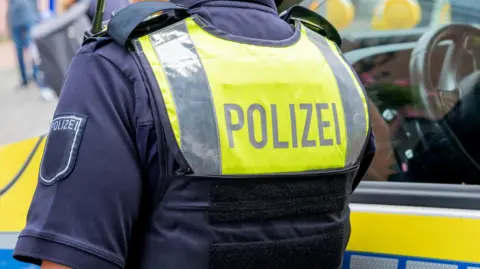 Getty Images
Getty ImagesFive men have been arrested in Germany suspected of being involved in a plot to drive a vehicle into people at a Christmas market.
Three Moroccans, an Egyptian and a Syrian were detained on Friday over the plan to target a market in the southern Bavarian state. Authorities said they suspected an "Islamist motive".
Prosecutors said the Egyptian - a 56-year-old - was alleged to have "called for a vehicle attack... with the aim of killing or injuring as many people as possible". The Moroccans allegedly agreed to carry out the attack.
Officials in Germany have been on high alert after previous attacks at Christmas markets, including in Magdeburg last December that killed six people.
Authorities did not say when the planned attack was supposed to take place or which market was the target, though said they believed it to be one in the Dingolfing-Landau area, north east of Munich.
German newspaper Bild reported the Egyptian man was an imam at a mosque in the area.
Police said the Moroccan men - aged 30, 28 and 22 - were arrested accused of having agreed to commit murder, while the Syrian man, a 37-year-old, was accused of encouraging the suspects "in their decision to commit the crime".
The five suspects appeared before a magistrate on Saturday and remain in custody.
Joachim Herrmann, Bavaria's state interior minister, told Bild the "excellent cooperation between our security services" had helped to prevent "a potentially Islamist-motivated attack".
Christmas markets are popular festive attractions throughout Germany, frequently attracting large crowds and significant tourism.
Security at events has been increased in recent years, since an attack in Berlin in 2016 when a man drove a lorry into a market crowd, killing 12 people.
A manhunt is under way after two students were killed and nine other people were injured in a mass shooting at Brown University in Providence, Rhode Island.
The gunman opened fire in a classroom at around 16:00 local time (21:00 GMT) on Saturday, in a building where exams were taking place.
The university, one of the oldest and most prestigious in the US, was placed into lockdown as police searched for the gunman, who remains at large.
Students in parts of the campus are continuing to be told to shelter in place until police can escort them out of the area.
Officials from Rhode Island Hospital said most of the injured are in a "critical but stable" condition.
The identities of those killed or injured have not yet been released by officials.
"This is a day that we hoped never would come to our community. It is deeply devastating for all of us," said Brown University President Christina Paxson in a statement.
Police have released limited information about the male suspect, including an identity or motive. It is not known if he has links to the university.
CCTV footage showed the suspect walking out of the building after the attack but the his face can not be seen.
Providence Deputy Police Chief Tim O'Hara said the suspect was dressed all in black and may have been wearing a mask. It is not known what type of firearm he used and it has not been recovered.
"We're utilising every resource possible to find this suspect," he added, with extra armed police resources drafted into to search the area.
The shooting happened at the Barus and Holley building, part of Brown University's engineering school. The attack happened in a large classroom on the first floor.
An economics professor told local public media outlet Ocean State Radio that the shooting took place during a review session for her course, which was led by her teaching assistant.
"He said that the shooter came in the doors, yelled something - he couldn't remember what he yelled - and started shooting," Rachel Friedberg said.
"Students started to scramble to try to get away from the shooter, trying to get lower down in the stadium seating, and people got shot," she added.
Officials cleared the building on Saturday afternoon but found neither the suspect nor a weapon.
Residents in the greater Brown University area have been told to stay inside, or to stay away until the shelter-in-place order is lifted.
In a statement, the university said police would enter non-residential buildings to escort people to safe locations.
Steph Machado, a reporter for the Boston Globe, told BBC News that restaurants around the campus have locked their doors with staff and customers waiting inside until the emergency order is lifted.
"There are flashing lights everywhere," she said.
In the immediate aftermath of the shooting, it was reported that a suspect had been taken into custody but it was quickly confirmed the man held had no involvement in the attack.
Mari Camara, 20, a Brown University student from New York City, told the Associated Press that she was coming out of the library and rushed inside a restaurant to seek shelter during the shooting. She spent the next three hours hiding there.
"Everyone is the same as me, shocked and terrified that something like this happened," Camara said.

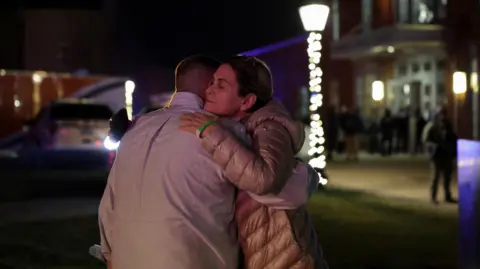 Reuters
ReutersUniversity exams scheduled for Saturday have been cancelled, provost Frank Doyle said.
President Donald Trump, speaking to reporters as he returned to the White House from attending the annual Army and Navy football game, described the shooting as "a terrible thing".
"All we can do right now is pray for the victims and for those that were very badly hurt," he said.
Rhode Island Governor Dan McKee said in a statement: "Our capital city experienced an unthinkable tragedy today. Our hearts are with the people of Providence and all those impacted."
Brown University, one of the one of the oldest higher education institutions in the US, is part of the Ivy League, a group of elite universities in the northeast of the country.
The university, which has more than 11,000 students, is located in Providence, Rhode Island's capital city, located about 50 miles (80km) from Boston and 180 miles (290km) from New York City.
The attack on the campus brings the number of mass shootings in the US to 389 for this year, according to the independent analysis website Gun Violence Archive (GVA).
It defines mass shootings as having four or more victims killed or injured, not including the attacker.

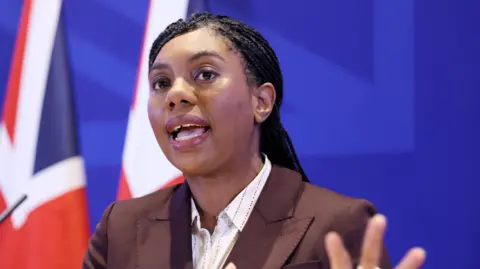 ANDY RAIN/EPA/Shutterstock
ANDY RAIN/EPA/ShutterstockKemi Badenoch says the Conservatives will scrap the ban on petrol and diesel vehicles due to come into force in the UK if they win the next election.
Writing in the Sunday Telegraph, the Conservative Party leader said the Zero Emission Vehicle mandate (ZEV) was a "well-meaning but ultimately destructive piece of legislation".
From 2030, all new cars will have to be electric or hybrid as part of government efforts to meet a legally binding aim of achieving "net zero" by 2050.
The Conservative leader's comments come after her meeting with Italian Prime Minister Giorgia Meloni, who has lobbied the EU to water down its own plans for a ban.
Net zero refers to the balance between the amount of greenhouse gas produced and the amount removed from the atmosphere.
Six EU countries, including Italy, have recently called on other member states to rethink plans to phase out new petrol and diesel cars by 2035, saying it could hurt industrial competitiveness.
Badenoch suggested the EU had signalled it would drop a full ban, adding: "The reality is that the EU's change of heart on EVs will leave Labour even more isolated, and by pressing ahead alone, we are placing our domestic industry at a disadvantage while giving others the opportunity to dominate global supply chains."
She said the only "winners in this economic self-harm are China".
The Conservative leader added that her government would still move towards a "transition to cleaner transport" but one driven by "affordability, practicality and technological progress" rather than "unrealistic mandates that weaken domestic manufacturing and empower foreign competitors".
She said scrapping the mandate would give "space" to rebuild the UK's car industry.
UK car firms were said to have been split over the 2030 deadline, with some calling for more support to be able to meet it.
In its latest Budget, the government announced an extra £1.3 billion investment into the UK's Electric Car Grant scheme to encourage drivers to make the switch to EVs.
Chancellor Rachel Reeves also announced that drivers of battery electric cars, which includes plug-in hybrids, will be charged 3p per mile for the Electric Vehicle Excise Duty from April 2028, with some arguing the move could make electric cars less appealing.
The ban on the sale of petrol and diesel cars was originally introduced in 2020 by then Prime Minister, Conservative Boris Johnson - Badenoch, a cabinet member at the time, opposed the plans.
It was later pushed back to 2035 by Rishi Sunak, with Labour pledging to bring it forward in its 2024 election manifesto.
A spokesperson for the Department for Transport said the government remained "committed to phasing out all new non-zero emission car and van sales".
They said: "More drivers than ever are choosing electric".
The next UK general election must be held by 15 August 2029, but the prime minister can opt to call an election at any point before this.
Rumours of a major prisoner release from Belarus had been swirling for a couple of days.
But no one would reveal the names on the list, or the exact number, until everyone was safely out, finally free.
In total,123 political prisoners have been released, including some of the best-known names among Belarusian opposition politicians, human rights activists and journalists.
Maria Kolesnikova, the protest leader with a famous red-lipsticked smile, was on the release list.
A video of her jumping for joy and hugging other former prisoners, overjoyed to be reunited, was soon flying around social media. Then came another, on a bus out of Belarus, where she thanked everyone who'd helped bring this moment about.
"It's a feeling of incredible happiness to see those who are dear to me, to hug them and realise we are all free," Masha, as she's best known, told the camera, her lips already painted red again.
The first sunset of her freedom was a thing of great beauty, she said.
"But I also think of those who are not yet free and I await the moment when we can all embrace, when all are free."

 Reuters
ReutersOut too is Viktor Babaryka, a banker who tried to run for president in 2020 but was locked up before the elections even began.
The Nobel Peace prize winner Ales Bialiatski has also been released from a 10-year sentence.
All were locked up for their opposition to the authoritarian rule of Alexander Lukashenko, whose security forces crushed the mass protests of 2020 with brutal force. They were the biggest challenge to his rule that he has ever faced.
The prisoners' release now is the result of long and complex negotiations led by the US that culminated in a two-day visit to Minsk this week by Donald Trump's new special envoy, John Coale.
For Lukashenko, that engagement itself is a win: after years as a political pariah in the West he is clearly happy to be back on talking terms with the US.
But he also got US sanctions dropped on a key export for his country, potash, as a further, more tangible reward. EU penalties - and tougher policies - are still in place.
It's not entirely clear what Trump has to gain from this. But Belarus is a close ally of Russia, including in its war on Ukraine, and the move comes as the US has been re-engaging with Moscow too, seeking a peace deal.

 EPA/Shutterstock
EPA/ShutterstockThe dozens of prisoners Lukashenko agreed to let go were always expected to come here to Vilnius, Lithuania, where a crowd of friends, relatives and fellow activists gathered outside the US embassy in the freezing cold to greet them.
Some came wrapped in the red and white opposition flag of Belarus.
Tatsiana Khomich, Masha Kolesnikova's sister who had campaigned for over five years for her release, couldn't stop smiling. "I've just spoken to Masha," she told me after a video call.
A professional flautist before the disputed 2020 elections, Kolesnikova spent much of her more than five-year sentence in total isolation, denied even letters and phone calls to her family.
"She's fine, she's good. I just want to hug her. I still can't quite believe it," her sister said.
Suddenly, there was a commotion in the crowd: a police car, blue lights flashing, was heading towards the US embassy gates, leading a small convoy of other vehicles.
But there was no way all 123 ex-prisoners were inside. Instead, we learned, just seven foreign nationals had been brought to Lithuania and only Ales Bialiatski of the Belarusians.
The others, including Kolesnikova, had been taken out of Belarus to Ukraine: from prison, into a war zone.
Staying in their own country is not usually an option on offer.
"Lukashenko's idea, who else?" was how one of opposition leader Svetlana Tikhanovskaya's team interpreted the surprise diversion to Ukraine. It seems he'd decided to play one final power game, so the family reunions, so long awaited, would be delayed.
But what of the price paid for that moment? Tikhanovskaya is a friend and political ally of Masha Kolesnikova, but she always calls for maximum pressure on Lukashenko by the West.
So has the US gone too far, I wondered.
"This is a process of negotiation. Of course, it would be good for us if nothing is given to Lukashenko, because all those people are hostages of his regime. They are innocent.
"But this is how negotiation goes," she replied, before noting that sanctions can always be reapplied if necessary.
"President Trump now uses carrots. He also can use sticks."
A few steps away, a man waving a giant flag worried that Lukashenko would just take more prisoners. This is not a sign of sudden humanity, he said.
After a short time inside the US embassy, Ales Bialiatski emerged onto the street to ecstatic cheers from the crowd.
Gaunt, head shaven and still in his padded blue prison jacket, he admitted his head was spinning from all the sensations after four years in jail.
"I was driven across Belarus in a blindfold, from east to west, so I still can't get my head round it. This is so emotional," he shared, describing being woken at 04:00 and told by his prison guard to pack.
When I asked what he wanted now most of all he didn't hesitate: "I want to see my wife!"
She's on her way, I was told.
Bialiatski's own organisation, Viasna, monitors political detentions in Belarus and the activist reminded everyone that many people like him - only less well known - have been left behind bars.
"It is very important for everyone to continue to work for those political prisoners who are still in Belarusian prisons, to strive for the complete release of all of them."
Then, lifting the red and white flag from his shoulders, he had a message for Belarusians everywhere.
"Optimism and activism," Ales Bialiatski told them, with a sudden smile. "Never give up!"

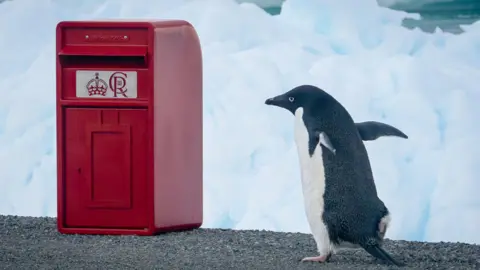 BAS/Martin Allen
BAS/Martin AllenA shiny new red post box has been given as a gift from King Charles III to staff at a remote Antarctic research station.
The Royal Mail red lamp post box was sent to staff at the Cambridge-based British Antarctic Survey station at Rothera.
The box, featuring the King Charles III cypher, was delivered after Kirsten Shaw, a station support assistant who runs the British Antarctic Territory Post Office for staff, requested an upgrade to their handmade box.
"Being in Antarctica is incredible, but it's full of extremes, so I think it's a special thing to send post back home, to communicate your experiences. It's a moment of your life that you put down on paper and give to someone else," she said.
The Rothera research station, which opened in 1975, is the largest British Antarctic Survey (BAS) facility, and a renowned global hub for climatic research.
It is situated 1,860km (1,155 miles) south of the Falkland Islands.
Staff work and live at the station for months at a time.
Ms Shaw said: "Getting post is really special for the team at Rothera.
"If you're doing fieldwork for many months, the feeling of receiving a letter — an actual tangible, piece of paper with handwriting from friends and family — is such a lift.
"It's a wonderful way to connect people that goes beyond what an email or text message can do."

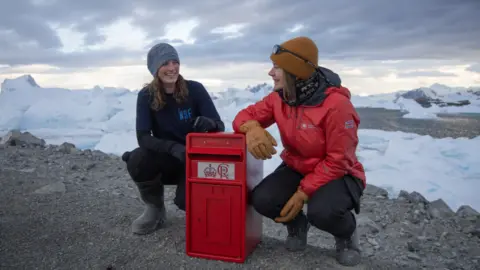 BAS/Jake Martin
BAS/Jake MartinThe box will replace the handmade and painted one currently used at the station.
The BAS said "the Royal Household worked with Royal Mail to arrange this particularly special delivery".
It was delivered to Rothera by the UK's polar research vessel RRS Sir David Attenborough, along with the first major drop of supplies to the station following the long Antarctic winter.
The post box will be installed in the Discovery Building, a new scientific support and operations hub.

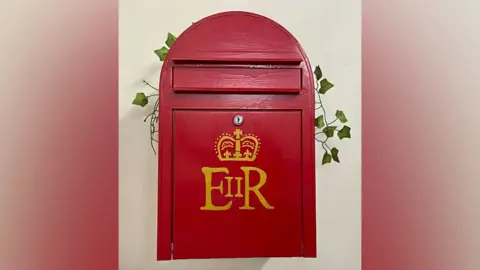 BAS/Aurelia Reichardt
BAS/Aurelia ReichardtPostal logistics in such a remote area are understandably not straightforward.
Ms Shaw's job is to oversee the formal Post Office logistics of getting mail in and out of Antarctica from Rothera, as well as getting post out to staff to other BAS stations and science field camps.
Post has to be gathered and put on board the RRS Sir David Attenborough or on BAS aircraft to the Falkland Islands, where BAS maintains an office in Stanley.
The final leg involves transport to RAF Brize Norton in Oxfordshire, where letters enter the Royal Mail postal network for onward delivery.

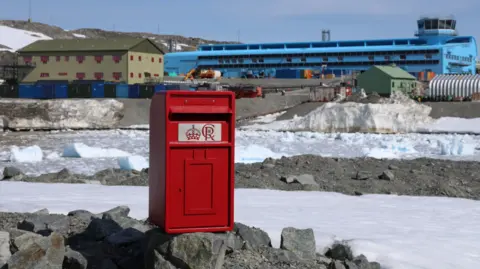 BAS/Jake Martin
BAS/Jake MartinJane Rumble, HM Commissioner for the British Antarctic Territory said: "Maintaining a postal service in the British Antarctic Territory is far more than a symbolic gesture.
"It reinforces Britain's presence and heritage in Antarctica and provides a vital link to the wider world."
Follow Cambridgeshire news on BBC Sounds, Facebook, Instagram and X.

 Getty Images
Getty ImagesFive men have been arrested in Germany suspected of being involved in a plot to drive a vehicle into people at a Christmas market.
Three Moroccans, an Egyptian and a Syrian were detained on Friday over the plan to target a market in the southern Bavarian state. Authorities said they suspected an "Islamist motive".
Prosecutors said the Egyptian - a 56-year-old - was alleged to have "called for a vehicle attack... with the aim of killing or injuring as many people as possible". The Moroccans allegedly agreed to carry out the attack.
Officials in Germany have been on high alert after previous attacks at Christmas markets, including in Magdeburg last December that killed six people.
Authorities did not say when the planned attack was supposed to take place or which market was the target, though said they believed it to be one in the Dingolfing-Landau area, north east of Munich.
German newspaper Bild reported the Egyptian man was an imam at a mosque in the area.
Police said the Moroccan men - aged 30, 28 and 22 - were arrested accused of having agreed to commit murder, while the Syrian man, a 37-year-old, was accused of encouraging the suspects "in their decision to commit the crime".
The five suspects appeared before a magistrate on Saturday and remain in custody.
Joachim Herrmann, Bavaria's state interior minister, told Bild the "excellent cooperation between our security services" had helped to prevent "a potentially Islamist-motivated attack".
Christmas markets are popular festive attractions throughout Germany, frequently attracting large crowds and significant tourism.
Security at events has been increased in recent years, since an attack in Berlin in 2016 when a man drove a lorry into a market crowd, killing 12 people.



据日本第11管区海上保安本部(那霸)介绍,14日,在冲绳县钓鱼岛周边、位于领海外侧的毗连水域内,日本海上保安厅的巡逻船确认有2艘中国海警局船只在航行。在钓鱼岛周边确认到中国当局船只,已连续30天,而中国海警局新闻发言人刘德军表示,12月2日,日“瑞宝丸”号渔船非法进入我钓鱼岛领海,中国海警舰艇依法对其采取必要管控措施并警告驱离。
据日本第11管区海上保安本部(那霸)介绍,14日在钓鱼岛周边航行的两艘海警船均搭载机关炮。日本巡逻船对其发出警告,要求不要接近日本领海。
日本海上保安厅2日发布消息称,在钓鱼岛周边的日本领海内,已将试图接近日本渔船的中国海警局船只驱离。另一方面,中国海警局同日表示,已将“非法”进入相关海域的日本渔船驱离。
据第11管区海上保安本部(冲绳县那霸市)称,2日凌晨2时27分至29分左右,在冲绳县石垣市尖阁诸岛大正岛近海的日本领海内,中国海警局2艘船只相继侵入,并表现出接近1艘正在航行的日本渔船的动向。这些海警船均搭载火炮。日本海上保安厅巡逻船要求其退去,两艘船均于当天5时12分左右驶离领海。这是自11月16日以来,中国海警船再次进入日本领海。据日本海上保安厅称,中国海警局船只自11月16日以来进入日本领海的情况,这是今年第26次;其中试图接近日本渔船的事件为第8起。
而据中国海警微信公众号报道:中国海警局新闻发言人刘德军表示,12月2日,日“瑞宝丸”号渔船非法进入我钓鱼岛领海,中国海警舰艇依法对其采取必要管控措施并警告驱离。钓鱼岛及其附属岛屿是中国固有领土,我们敦促日方立即停止在该海域的一切侵权挑衅活动。中国海警将持续在钓鱼岛海域开展维权执法活动,坚决维护国家领土主权和海洋权益。

据中央社报道,美国布朗大学发生枪击事件酿2死8重伤,另有1人遭子弹碎片擦伤,罗得岛州警方目前正全力追缉嫌犯。台湾博士生简江恒向媒体表示,事发后,他在实验室桌下躲了2个小时。
中央社指出,综合路透社和美国国家广播公司(NBC)报导,事发时,正在校园实验室的来自台湾的工程学博士生简江恒(Chiang-Heng Chien,音译)表示,枪声响起后,大家都躲到桌子底下。
简江恒接受NBC地方电视台WJAR采访时表示:“我们决定把灯关掉,门全部关上,然后藏在桌子底下。”
简江恒说,两小时过后,警方进入现场,并通知他们必须尽快撤离,以利警方净空大楼、搜寻攻击者。
布朗大学(Brown University)位在罗得岛州首府普罗维登斯(Providence),校内拥有数百栋教学、实验及宿舍等建筑。
校长帕克森(Christina Paxson)已证实,罹难及伤者全部都是校内学生,并感叹:“这是我们最不愿遇到的一天,但它终究发生了。”

(德国之声中文网) 1999年9月21日凌晨1点47分,规模 7.6 的九二一大地震震撼全台。德国联邦搜救犬协会(Der Bundesverband Rettungshunde e. V., BRH)在震后迅速启动应急机制,在地震发生未满24小时便出发,约15小时后抵达台湾。这支救援队共有10名队员与8只搜救犬,携带约1500公斤的专业救援器材赶到灾区。
BRH队伍首先抵达台北,部分队员随后被派往台湾中部的重灾区支持。在救援行动中,队伍来到一栋倒塌的15层高楼前,据报导,废墟里唯一生还者是德国救难队救出的,该事件象征两国搜救合作的重要里程碑。
Nicole Gies 回忆当年的救援行动
BRH 领犬员 Nicole Gies 女士回忆道:“我当时26岁,第一次参加海外救援。我的狗 Lilli(莉莉)是一只体型小、毛色浅的黄金猎犬。我们大约在1999年9月22、23日抵达台湾,下飞机后先到台北报到,听取简报后便带着装备前往指派的搜救区域。”

她说,“搜救过程中,有一只其他队伍的搜救犬首先发出特别吠声,我们立即循着声音赶往现场。此时莉莉也确认废墟中可能有人。于是我们使用生命探测仪等器具搜寻生还者,并与其他国家的搜救队共同作业。最终,我们成功救出一位妇女,这次任务让我们都感到非常庆幸。”
这段历史不仅展现了搜救犬的专业能力,也见证了台、德两国在救灾领域的合作与友谊,为后续国际搜救训练与交流奠定了重要基础。
十多年后, 2017 年,Nicole Gies 再度踏上台湾的土地。不过这一次,她和她的伙伴不再是来救灾,而是协助训练搜救犬并办理国际认证程序。自此之后,除了新冠疫情期间,BRH 基本上每年都会派员赴台,台湾的训犬师每年也会前往德国拜访BRH,持续深化两国在搜救犬训练与国际认证上的合作。

921:一场天崩地裂的大地震
921大地震造成近2500人死亡、29 人失踪,超过1万人受伤。全台湾约十万五千户房屋倒塌或严重损坏,财产损失达2000多亿新台币(约64亿美元)。地震教育园区解说员黄惠瑛表示,当年共有来自20个国家、41个团体的767名搜救人员及99只搜救犬抵达台湾协助救灾,其中包括德国、美国、日本、韩国、俄罗斯、土耳其及法国等国。
黄惠瑛回忆起往事,当年的她只有17岁,还是高二学生,为了求学,独自离家到台中,住在学校附近的一栋公寓里。地震发生在深夜,她正准备上床睡觉,突然听到楼上阳台传来东西摔落的声音,夹杂着玻璃破碎的响声。随即整栋楼剧烈摇晃,彷佛房子要被撕裂。她还来不及弄清楚发生了什么事,想开灯却发现已经停电。
当她惊慌失措、不知该如何自处时,忽然听到外面有人大喊:“快下楼!房子要倒了!” 她赶紧逃到楼下,与其他人一起撤离到一个宽敞的十字路口避难。不久,有人冒险返回住处拿来一台收音机,透过广播才得知台中附近的南投(地震重灾区)遭到毁灭性破坏,交通全面中断。虽然四周一片漆黑,黄惠瑛仍看到远方多处火光冲天。回过神来,她听到许多人在哭泣、在呼喊,一切显得格外彷徨无助。
黄惠瑛称,她这一生从未经历过如此黑暗的夜晚,而且那晚的风特别凉,几乎沁入背脊深处。她的家人和好友大致平安,但同校的同学中有人在地震中丧生。

灾后台湾重新建置救灾系统
1999年发生九二一大地震时,台湾的消防救难体系尚在发展阶段。幸运的是,当时有41支国际搜救队抵台协助救灾,并在灾区顺利抢救出零星的生还者。这次经验让台湾政府深刻感受到亟需提升大型灾害的搜救能力。
因此,内政部于2002年成立消防署特种搜救队,其中包含搜救犬训练队伍。特搜队负责进行震灾、急流、重大交通事故、山难等各项专业搜救训练。他们致力于三大任务:直升机立体救灾、国内重大灾害抢救,以及国际人道救援。
此外,特搜队还承担提升全国特搜能力与救援效率的责任。他们推动全国搜救队能力认证计划,建立国内外灾区的共同语言与标准化救灾机制,并积极参与国际交流,建立伙伴合作关系。透过多面向的经验交流,台湾搜救队的专业能力得以持续提升,为未来灾害应变奠定了坚实基础。

台德救灾上的具体交流
九二一大地震后,台湾各县市开始培训搜救犬。2016 年,BRH首度邀请内政部消防署的搜救队伍赴德训练。2017年,德方来台进行共同训练,并与台中市消防局签署合作备忘录。2019年,台湾搜救队第二次赴德国训练。
2023年3月,内政部消防署与BRH正式签署合作备忘录,并在南投设立BRH在台办公室与训练据点,进一步深化合作。2024 年 9月,台湾搜救队又与德国搜救队(International Search and Rescue,ISAR)签订合作备忘录,以加强搜救协作。BRH主要训练救难犬,而 ISAR 则负责所有救难工作,包括火灾、淹水、山难等。
BRH教官团队多次来台进行为期数天的训练,内容涵盖理论学习、肢体语言识别、助手训练、瓦砾搜索与路径追踪等多项专业技能。透过这些合作,台湾搜救犬队在瓦砾搜救与路径搜索等专门能力上得到明显提升。

20年培训有成
如今,台湾的搜救犬在国际认证与比赛中取得多项优异成绩。2023年,新北市消防局的搜救犬队伍由领犬员罗浩芳与搜救犬 Amei 组成。他们参加了国际搜救犬组织(IRO)的 Mission Readiness Test(MRT)认证,创下“队史最佳成绩”,并顺利通过 MRT 认证。

早在2019年,台湾便承办了搜救犬国际任务能力认证测验(MRT)。这项由 IRO 认证的高阶国际测验中,当年共有6只台湾搜救犬成功通过认证,其中包括曾在花莲地震中成功寻获受困者的搜救犬“铁雄”。
根据2018年《Taipei Times》报导,亚洲区共有9只搜救犬获 IRO/联合国认证,其中台湾占7只,日本占2只。报导指出,这些经认证的搜救犬可被联合国用于人道救援任务。

救难犬训练和认证:台德合作愉快
德国联邦救难犬协会(BRH)副主席 Ulrike Gehner女士对 DW 表示,台德合作非常顺利,双方沟通直接且坦诚,在此基础上将持续深化合作。她强调,维持这样的合作关系,是双方既定计划中的重要部分。
Gehner 承认自己尚未以游客身份访问台湾,但曾短暂造访日月潭,留下深刻印象。2024 年,她曾走了一小段台北象山的步道,对景色赞不绝口。Gehner 表示,她对健行和爬山特别感兴趣,希望未来有机会更深入探索台湾。虽然尚未到台湾度假过,但这已成为她个人的首要愿望。
DW中文有Instagram!欢迎搜寻dw.chinese,看更多深入浅出的图文与影音报道。
© 2025年德国之声版权声明:本文所有内容受到著作权法保护,如无德国之声特别授权,不得擅自使用。任何不当行为都将导致追偿,并受到刑事追究。

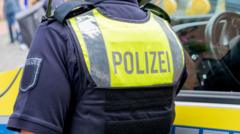
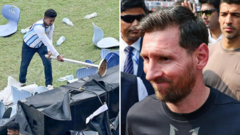
台湾总统赖清德星期一预定邀请立法院院长韩国瑜茶叙,欲解决朝野僵局,但韩国瑜表态拒绝。国民党主席郑丽文星期天说,如果赖清德不去面对自己每天违法乱宪行径,只是虚情假意地想要找人来喝茶摸头,是没有办法解决问题的。
综合《联合报》、风传媒、中天新闻网等报道,赖清德为《财划法》、年金改革等修法议题,星期一(12月15日)邀请行政院、立法院及考试院院长到总统府进行“国政茶叙”,但韩国瑜已表达不克出席。赖清德上星期六(12月13日)就此说,“我们知道韩院长也有难言之隐,不过请他再思考一下”。
国民党屏东县党部星期天(12月14日)举行周年党庆,郑丽文出席活动时受访说,这是一个非常重大的宪政危机,“中华民国”领导人带头违宪,动摇民主最重要的基石、立法院的运作。
郑丽文进一步说,立法院多数通过的法案与预算,行政部门必须遵守,而行政院复议也提了,也失败了。她称,既然所有的宪政手段已经穷尽,就应该遵守宪法,而不是毁宪蛮干。
郑丽文还点名批评赖清德,立法院不是耍流氓或胡搅蛮缠的地方,“台湾民主得来不易,岂容你一次的任性,就任由你来践踏呢?”
郑丽文指出,如果赖清德不去面对自己每天违法乱宪的行径,只是虚情假意地想要找人来喝茶摸头,是没有办法解决问题的;若总统令不出总统府,致使台湾陷入僵局,原因都是赖清德的任性胡为,“我们不能在内耗下去,台湾不应该如此非理性恶斗,我们付不起这种代价”。
郑丽文也呼吁赖清德应及早悔悟,不要再执迷不悟。
民众党主席黄国昌早前也呼吁,赖清德应放下身段,并形容与在野党主席公开对谈,才是最有效方式。
另一方面,台湾总统府宣布,赖清德预计星期一上午10时30分,邀请行政院长卓荣泰和考试院长周弘宪各自率副院长一起参与闭门的“国政茶叙”,会后将有新闻稿说明。

法新社周日(12月14日)消息称,特朗普承认,尽管他认为自己执政近一年来在经济方面取得了成功,共和党仍有可能在2026年的中期立法选举中失利。他在《华尔街日报》周六晚间刊出的专访中作出了上述表态。
特朗普在接受该媒体采访时说:“我打造了史上最伟大的经济。但人们需要时间才能意识到这一点。”
他还说:“大量资金正在涌入我们的国家,目前正在用来建设各种项目:汽车工厂、人工智能,还有很多东西。(但是)我无法告诉你,这最终会如何转化为选民的感受。我能做的只有把我的工作做好。”
自今年1月20日重返白宫以来,特朗普一直坚称美国经济正在蓬勃发展,并持续将通货膨胀的责任归咎于前任总统拜登。
他在采访中说:“我认为,到我们真正谈论选举的时候,也就是再过几个月,物价水平会处在一个良好的状态。”
距离2026年中期选举还有近一年,届时将于11月初改选众议院全部席位及参议院三分之一的席位。
在《华尔街日报》的采访中,79岁的特朗普似乎一直在为自己找台阶下,他甚至称,即便是那些执政非常成功的总统,也曾在中期选举中遭遇挫败。他说:“我们拭目以待会发生什么。我们应该会赢。但你知道,从统计角度来看,赢得中期选举是非常困难的。”
此外,他于本周二(12月16日)在接受政治媒体Politico采访时曾表示,美国这一全球最大经济体的表现可以打“25分满分中的20分”(相当于A+++++)。
特朗普反复强调,物价正在下降,然而许多美国民众仍在抱怨生活成本居高不下。芝加哥大学公布的一项民调显示,仅有31%的美国人对特朗普的经济政策感到满意。

美国罗德岛州布朗大学(Brown University, Rhode Island)发生重大枪击事件,造成2名学生死亡、9人受伤后,警方正全力展开追捕行动。据法新社报道,枪手于当地时间周六13日约16:00(格林尼治标准时间21:00)在一间教室开枪,事发时该大楼正进行期末考试。大学目前进入封锁状态。
报道表示,在枪手对正在进行考试的教学楼开枪数小时后,位于罗德岛州普罗维登斯的该大学周围街道上布满了紧急车辆。
这起暴力事件是美国发生的一长串校园袭击中的最新一起,在美国,限制枪支获取的尝试面临着政治僵局。
目击者凯蒂·孙(Katie Sun)告诉布朗大学的学生报纸《布朗每日先驱报》(Brown Daily Herald),她当时正在附近的一栋楼里学习,听到了枪声。她跑回宿舍,把所有物品都留在了身后。
她说:“说实话,这非常可怕。枪声听起来像是来自……教室所在的区域。”
枪击事件发生八小时后,枪手仍在逃,约400名警察,从联邦调查局(FBI)特工到校园警察,蜂拥至这个古雅的新英格兰校园。
普罗维登斯市长布雷特·斯迈利(Brett Smiley)在新闻发布会上说:“我可以确认,今天下午有两人死亡,另有八人情况危急,但已稳定。”
当局称,第九名“被枪击碎片击中”的人随后被送往医院。
警方公布了一段10秒长的嫌疑人录像,显示他在一楼教室开枪后,背对着镜头,疾步走在一条空旷的街道上。
布朗大学校长克里斯蒂娜·帕克森(Christina Paxson)在深夜的新闻发布会上表示,11名受害者中有10人是学生。
罗德岛州参议员谢尔登·怀特豪斯(Sheldon Whitehouse)在X上发帖称:“我的心为那些原本期待着假期休息,却不得不面对又一起可怕的大规模枪击事件的学生们而破碎。”
根据“枪支暴力档案”(Gun Violence Archive)的数据,今年到目前为止,包括这起事件在内,美国已发生300多起大规模枪击事件,该机构将“大规模枪击”定义为四人或四人以上被枪击的事件。
普罗维登斯紧急事务管理机构在社交媒体上表示,就地避难命令仍然有效。
普罗维登斯市长斯迈利表示,市政府官员“认为没有必要”让当地居民取消周末或整周与假期相关的计划。
斯迈利补充说:“在最初枪击事件发生后的几个小时里,我们没有收到任何关于该个人构成特定持续威胁的额外可信信息。”
大学官员表示,原定于周日举行的期末考试已被推迟。
期末考试
枪击事件发生在常春藤盟校布朗大学校园内的巴鲁斯与霍利大楼(Barus and Holley building),该大楼是工程系和物理系的所在地。
大学表示,枪击发生时,大楼内原定有两场考试。
执法部门将嫌疑人描述为一名身着全黑服装的男子。
警察局副局长蒂莫西·奥哈拉(Timothy O'Hara)在新闻发布会上说:“我们正在动用一切可能的资源来寻找这名嫌疑人。就地避难命令仍然有效,我敦促人们非常认真地对待。请不要来到该地区。”
当局表示,最后一次看到枪手是离开大楼时,目前尚未找到任何武器。
布朗大学在下午4点22分(格林威治时间21点22分)发出了紧急警报,报告“巴鲁斯与霍利工程大楼附近有活跃枪手”。
警报称:“锁好门,手机调成静音,保持躲藏,直到另行通知。”
执法人员和急救人员蜂拥至现场,当地新闻台WPRI报道称“人行道上有衣物和血迹”。
美国总统唐纳德·特朗普已听取了枪击事件的简报。
他说:“这是一件多么可怕的事情。我们现在能做的就是为受害者祈祷。”
位于波士顿附近的普罗维登斯布朗大学约有11,000名学生。
美国历史上最致命的校园枪击事件发生在2007年4月16日的弗吉尼亚理工大学,当时韩国学生赵承熙(Seung-Hui Cho)杀害了32人,打伤了17人,然后自杀。

据法新社最新消息,布朗大学校长克里斯蒂娜·帕克森(Christina Paxson)在给社区成员的一封信中证实,所有 11名受害者均为学生。
法新社援引帕克森在学校网站上发布的信中说:“我们社区中有九名成员被送往当地医院,他们都是学生。而且我们在这场毁灭性的枪支暴力中失去了两名学生。”
“我们从医院了解到,有六名学生仍处于危急但稳定的状态。一名学生情况危急,另一名学生情况稳定,还有一名学生经过治疗后已出院。”
根据“枪支暴力档案”(Gun Violence Archive)的数据,今年到目前为止,美国已发生300多起大规模枪击事件,该机构将“大规模枪击”定义为四人或四人以上被枪击的事件。
普罗维登斯紧急事务管理机构在社交媒体上表示,就地避难命令仍然有效。
普罗维登斯市长布雷特·斯迈利(Brett Smiley)表示,市政府官员“认为没有必要”让当地居民取消周末或整周与假期相关的计划。
斯迈利说:“在最初枪击事件发生后的几个小时里,我们没有收到任何关于该个人构成特定持续威胁的额外可信信息。”
大学官员表示,原定于周日举行的期末考试已被推迟。
紧急警报
拥有约11,000名学生的布朗大学在下午4点22分(格林威治时间21点22分)发出了紧急警报,报告称“巴鲁斯与霍利工程大楼附近有活跃枪手”,该大楼是工程系和物理系的所在地。当时,该大楼内原定有两场考试。
这所常春藤盟校称:“锁好门,手机调成静音,保持躲藏,直到另行通知。”
执法人员和急救人员蜂拥至现场,当地新闻台WPRI报道称“人行道上有衣物和血迹”。
当局敦促任何知情者提供信息。
警察局副局长蒂莫西·奥哈拉(Timothy O'Hara)在新闻发布会上表示:“我们正在动用一切可能的资源来寻找这名嫌疑人。就地避难命令仍然有效,我敦促人们非常认真地对待。请不要来到该地区。”
他说,最后一次看到枪手是离开大楼时,目前尚未找到任何武器。
美国总统唐纳德·特朗普已听取了枪击事件的简报,称该事件是“一件可怕的事情”。
他说:“我们现在能做的就是为受害者祈祷。”

(德国之声中文网)巴黎卢浮宫博物馆官员周日(12月7日)确认,11月发生的漏水事件导致大量具有历史价值的书籍受损。
漏水地点位于博物馆的莫里安馆翼楼(Mollien Wing),该区域是埃及古物部的所在地。
漏水事件是否导致文物受损?
副馆长弗朗西斯·斯泰因博克(Francis Steinbock)淡化了此次事件的严重性。他说,漏水是在11月26日被发现的,有“300到400件”19世纪末和20世纪初的藏品受损。斯泰因博克表示,这些历史书籍“非常有用,但绝非独一无二”。
斯泰因博克说:“没有任何文物受损。”他补充道,“目前,我们在这些馆藏中没有不可修复或永久性的损失。”
他说,受损书籍将被“烘干,送到装订师那里修复,然后重新上架”。
然而,这一说法遭到专业在线杂志《艺术论坛》(La Tribune de l'Art)在周六发表的一篇文章针锋相对的反驳。
文章指出,一些书籍的装帧已被不可逆地损坏,并指责博物馆管理层无视埃及古物部多次提出的改善建筑环境及采取保护措施的请求。
卢浮宫管理事故接二连三
此次漏水事件只是这座世界上参观人数最多的博物馆最近一系列负面新闻中的最新一起。
去年10月发生过震惊全球媒体的新闻:一个周日清晨的胆大包天的盗窃案中,四名嫌疑人携带价值超过1.02亿美元(约8760万欧元)的历史王冠珠宝逃离。人们认为,这些珠宝的历史价值不可评估,而专业人士担心它们可能已经被销毁并分拆出售。
去年11月,由于结构安全问题,博物馆被迫关闭一间展示希腊花瓶的展厅。

博物馆表示将对11月26日的漏水事件展开调查。这次事故并非意外。斯泰因博克说,相关风险早已知晓,老旧管道系统已被关闭,并计划在2026年9月更换。
看起来,旧暖气系统中的一个阀门被错误地打开,导致楼上地毯被浸湿。当地毯吸水饱和时,水开始从天花板滴落,落在下面的历史书籍上。
博物馆支出优先次序遭到质疑
为了增加收入并为这座庞大文化建筑群的改造筹措资金,卢浮宫管理层近期宣布调整门票价格。
博物馆表示,对非欧盟游客的门票价格上调45%,为32欧元,将使年收入增加2300万美元。
卢浮宫每年870万名访客中,约69%来自国外。
法国审计法院近日在评估博物馆的支出优先次序时,批评其艺术品采购政策,指出高额的新藏品购置支出造成其他领域预算短缺。
《艺术论坛》也批评博物馆优先次序严重失衡,指出管理层办公室的奢华家具与装修改造开支巨大,而博物馆其他部分在基础设施、安全与安保改善方面被迫长期拖延。
DW中文有Instagram!欢迎搜寻dw.chinese,看更多深入浅出的图文与影音报道。
© 2025年德国之声版权声明:本文所有内容受到著作权法保护,如无德国之声特别授权,不得擅自使用。任何不当行为都将导致追偿,并受到刑事追究。
